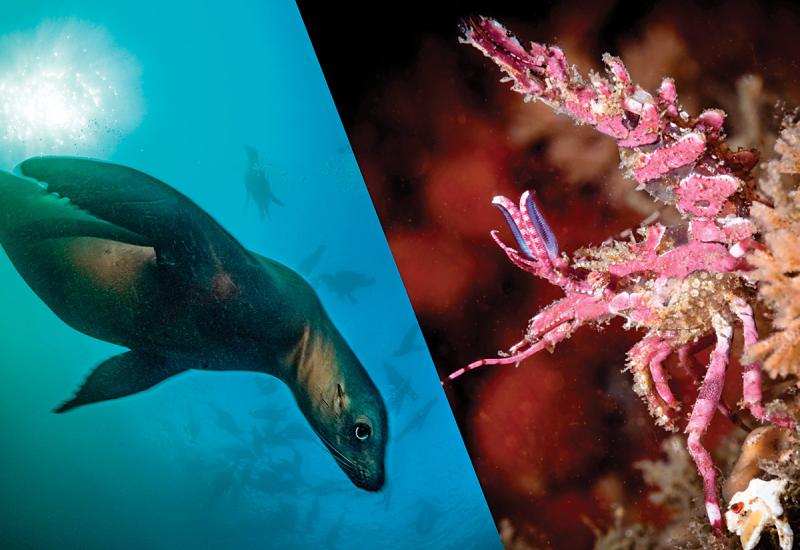A Titanic Finding: What It’s Like to Discover a Deep Sea Reef

OceanGate ExpeditionsOceanGate submersible Titan diving beneath the surface of the ocean during the 2021 Titanic Expedition
Back in 1996, veteran Nautilus and submersible pilot and Titanic diver P.H. Nargeolet detected a sonar blip on the seafloor close to the Titanic, but at depths about a kilometer shallower.
But it wasn’t until OceanGate Expeditions’ 2022 Titanic Expedition, that he returned by submersible to the previously recorded blip, some 2900 meters (9514 feet) under the ocean’s surface, with a group of researchers and expecting to find a possible shipwreck due to the size of the structure.
What the sonar blip revealed to Nargeolet and his team, however, was a never-before-seen, deep-ocean rocky reef.
Murray Roberts, a professor of applied marine biology and ecology at the University of Edinburgh in Scotland who studies deep sea and cold water corals, was on the 2022 expedition with Nargeolet and calls witnessing the undiscovered reef “a rare privilege.”
We sat down with Roberts to hear just what it’s like to lay eyes on a deep sea reef never before seen by humans.
It’s a Rare Privilege
Entering the water in the submersible, the surface waters are quite warm and blue with the Gulf Stream influence. The sun was shining right in through the large viewport on Titan. Light from the surface is no longer visible after descending about 1000 meters. The Titan submersible has powerful lights that allow us to see our surroundings in the darkness. At times we turn the lights off, allowing us to observe bioluminescence from the fauna that live in the water column.
I was very curious whether we’d find the feature seen on the sonar in 1996. It’s one point on a deep seafloor–a very big ocean and a very small target.

OceanGate ExpeditionsBeautiful deep sea corals and sponges as seen through Titan's viewport during the dive that discovered the Nargeolet-Fanning Ridge
The sonar had picked up a lump on the seafloor. It appeared to be somewhat scattered across a large area on sonar and everyone was thinking it looked like a wreck.
When we reached the seafloor, we didn’t see a large structure. Initially, we weren’t finding anything. We were seeing occasional rocks and the marks left by animals moving across the muddy seafloor. You could see scouring by the rocks, showing us the current must be strong at times. PH suggested going upslope and suddenly what looked like the bow of a ship came into view on the scanning sonar. There was a lot of excitement in the sub.
We got closer and closer, and I’m nimble enough to be moving around in the sub and I could see out the single view port of Titan.

OceanGate ExpeditionsThe bow of the Titanic seen through the viewport of OceanGate's Titan submersible
It was very clearly igneous rock going straight up in front of us. It wasn’t a shipwreck at all. It was a ridgelike structure and I straightaway noticed sponges and deep-sea corals growing there. It was a significant discovery for me because I’ve specialized in deep sea coral and sponges for the last 25 years.
We were looking at this rocky reef life structure upon which corals, including black corals, and sponges are settling and it’s really amazing. It reminded me of a seamount, an extinct underwater volcano, with the characteristic dark black igneous rock with bright white sponges just shining out at you.
The corals can have some colors to them, pinkish or reddish. But it was the fields of glass sponges–they’re made of silica and look just bone white–that were the most staggering things to see. They rise in vase-like structures or lollipop-like structures. Some bend beautifully in the current.

OceanGate ExpeditionsStockton Rush (left), President of OceanGate Expeditions, with the crew that discovered the Nargeolet-Fanning Ridge including author Murray Roberts (right.)
I’ve seen similar densities on seamounts in the Eastern Atlantic at similar water depths and it’s really indicative of that very suitable habitat in a place that’s unchanged for long periods. Sponges are hard to age, so we often have a very poor handle on how old they are. But some were very large, and in all probability are extremely old.
You see this delicate vase coming up from the seafloor and you can see within the sponge, the lights of the submersible pick up the glassy white of the body of the sponge. There were a number of deep sea fish down there, too, like grenadiers. Some of these fish are very slow growing and extremely long lived. But deep sea corals hold the record for longest lived animal species and can live thousands of years – scientists can use carbon dating to age the corals.
We find these kinds of species right across the Atlantic and have been wondering how they’re getting from place to place as effectively as they are.
We know they spawn, they liberate larvae into the water, but the biology of it is very poorly understood. And we know reefs like this, the Titanic and other shipwrecks are important stepping stones, forming a network of connectivity in the oceans.
In hundreds of years, the Titanic will return to nature again–still serving as an artificial reef but eventually deteriorating due to the iron-eating bacteria and strong ocean currents. It will become buried under the sediments and marine snow. But the volcanic ridge will still be there. This rocky ridge is a fascinating place, helping us understand how species move from one place to another. And it’s a natural deep sea reef compared to the artificial reef the Titanic now forms.
From my scientist’s standpoint, that made this a much more useful trip–when you have things to compare and contrast in nature, it helps to understand what’s driving different processes in the deep Atlantic.

e8d8.jpg)








